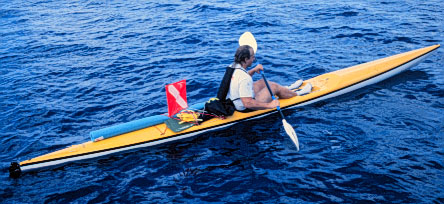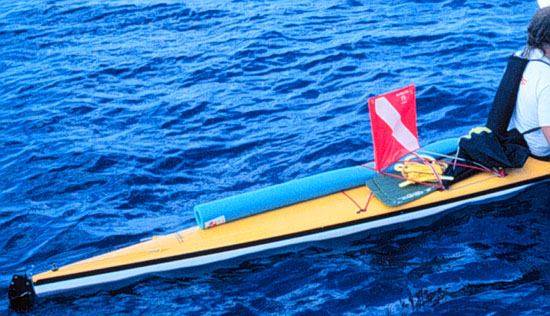Freediving and Kayaking...
|
Large waves may prevent beach launches with normal scuba style kayaks, but
with the surfski, large waves are just another thrill. With a 20 foot long hull,
even 8-12 foot surf is manageable for good paddlers. |
 Of course there is a catch...how can these boats be so fantastic, and yet be
so unknown to divers? The big reason is the learning curve. You can't buy one of
these boats and dive on it on day one. If you would not consider yourself
athletic, then the surfski would probably be a huge mistake for you. Of course there is a catch...how can these boats be so fantastic, and yet be
so unknown to divers? The big reason is the learning curve. You can't buy one of
these boats and dive on it on day one. If you would not consider yourself
athletic, then the surfski would probably be a huge mistake for you.
But let's assume you are well coordinated, aerobically fit, and in search of
athletic challenge. Figure 3 to 5 practice outings without dive gear, if you are
exceptional at dynamic balance sports. On your first you will tip...alot. On
your second you may still tip, but you should start to see the light at the end
of the tunnel----you start to figure things out. |
|
By your third time on the surfski, you may be ready to try some fast
paddling and some real waves. Two or three hours of paddling later and you will
have graduated to what might be called a novice surfski paddler. From here on
you will learn more everytime you go out and paddle. You will begin to seek out
large waves, and try them head on, then from behind, and then even from the
side. After a dozen or so paddling trips of 2 to 4 hours each, you should make
it to a low level intermediate ability level, and it should be time to add the
fins, and other freediving gear, and head out to a reef.
By this time, you should have realized something has happened to you. Like a
runner who has started biking for a triathlon, all of a sudden he realizes he
has become a cyclist as well as a runner. Now the freediver becomes a surf ski
paddler as well----a kind of an oceanic bi-athlete. This is actually an
essential step, since the skill needed for real autonomy on the ocean requires
complete mastery of the surf ski. This skill, derived from compulsive desire to
enjoy this new sport (surf skiing/kayaking), creates a very different freediver.
Bad weather becomes a friend, a new training buddy. Bad weather dive sites are
discovered and enjoyed when others are sitting indoors. |
 As you can see, a freediver has room for all his equipment, As you can see, a freediver has room for all his equipment, |
|
As the close up below shows, fins, and tow line are bungeed down behind you
in easy reach. Water is carried on the back of the paddler, by an accessory
known as a Camelbak ( available in good bicycle shops anywhere) They allow hands
free drinking, and can hold over 32 ounces. . The gun has its handle exposed
from the blue tube for a "quick draw", right by this freediver's left
hip. A foam bag can open up to put fish in, and the line ties to the gun, with
the surfski acting as the float on the surface. There is a bungee on the bow
line to prevent sudden forces from damaging the boat---good for fish under 50
pounds---any 500 pound tuna hunters with this boat would need a strap over the
seat area to take over major stress when the bungee on the bow stretches beyond
a certain point---this being the load bearing area of the boat which could take
several hundred pounds of downward pull. |
 *Note...The blue tube is a foam "pool toy", which is perfect to
put the speargun inside of, much like a rifle holster on a western saddle. This
protects the boat and the gun from each other, and also will float your gun if
you ever had a catastophic dumping on a surf re-entry. (8 to 12 foot waves in
the surf zone need to be ridden in straight, you can't take angles like a
surfboard....and you must hit maximum speed just before the wave catches you
from behind, to prevent the tail of the boat from puncturing through the wave
and sticking out its back---leaving you with a rudder turning in the air. While
some practice will allow entries with 12 foot or larger waves feasible, or even
fun, a mistake on this large a wave will scatter your equipment no matter how
well its tied down. In Palm Beach, if the winds kicked up the seas to much over
12 footers while I was out (say from 6 footers), I would be inclined to come in
at an inlet instead of the surf zone at the beach. *Note...The blue tube is a foam "pool toy", which is perfect to
put the speargun inside of, much like a rifle holster on a western saddle. This
protects the boat and the gun from each other, and also will float your gun if
you ever had a catastophic dumping on a surf re-entry. (8 to 12 foot waves in
the surf zone need to be ridden in straight, you can't take angles like a
surfboard....and you must hit maximum speed just before the wave catches you
from behind, to prevent the tail of the boat from puncturing through the wave
and sticking out its back---leaving you with a rudder turning in the air. While
some practice will allow entries with 12 foot or larger waves feasible, or even
fun, a mistake on this large a wave will scatter your equipment no matter how
well its tied down. In Palm Beach, if the winds kicked up the seas to much over
12 footers while I was out (say from 6 footers), I would be inclined to come in
at an inlet instead of the surf zone at the beach. |
Click here to learn more about Surfski's and
Kayaking techniques.

 Of course there is a catch...how can these boats be so fantastic, and yet be
so unknown to divers? The big reason is the learning curve. You can't buy one of
these boats and dive on it on day one. If you would not consider yourself
athletic, then the surfski would probably be a huge mistake for you.
Of course there is a catch...how can these boats be so fantastic, and yet be
so unknown to divers? The big reason is the learning curve. You can't buy one of
these boats and dive on it on day one. If you would not consider yourself
athletic, then the surfski would probably be a huge mistake for you.
 As you can see, a freediver has room for all his equipment,
As you can see, a freediver has room for all his equipment, *Note...The blue tube is a foam "pool toy", which is perfect to
put the speargun inside of, much like a rifle holster on a western saddle. This
protects the boat and the gun from each other, and also will float your gun if
you ever had a catastophic dumping on a surf re-entry. (8 to 12 foot waves in
the surf zone need to be ridden in straight, you can't take angles like a
surfboard....and you must hit maximum speed just before the wave catches you
from behind, to prevent the tail of the boat from puncturing through the wave
and sticking out its back---leaving you with a rudder turning in the air. While
some practice will allow entries with 12 foot or larger waves feasible, or even
fun, a mistake on this large a wave will scatter your equipment no matter how
well its tied down. In Palm Beach, if the winds kicked up the seas to much over
12 footers while I was out (say from 6 footers), I would be inclined to come in
at an inlet instead of the surf zone at the beach.
*Note...The blue tube is a foam "pool toy", which is perfect to
put the speargun inside of, much like a rifle holster on a western saddle. This
protects the boat and the gun from each other, and also will float your gun if
you ever had a catastophic dumping on a surf re-entry. (8 to 12 foot waves in
the surf zone need to be ridden in straight, you can't take angles like a
surfboard....and you must hit maximum speed just before the wave catches you
from behind, to prevent the tail of the boat from puncturing through the wave
and sticking out its back---leaving you with a rudder turning in the air. While
some practice will allow entries with 12 foot or larger waves feasible, or even
fun, a mistake on this large a wave will scatter your equipment no matter how
well its tied down. In Palm Beach, if the winds kicked up the seas to much over
12 footers while I was out (say from 6 footers), I would be inclined to come in
at an inlet instead of the surf zone at the beach.